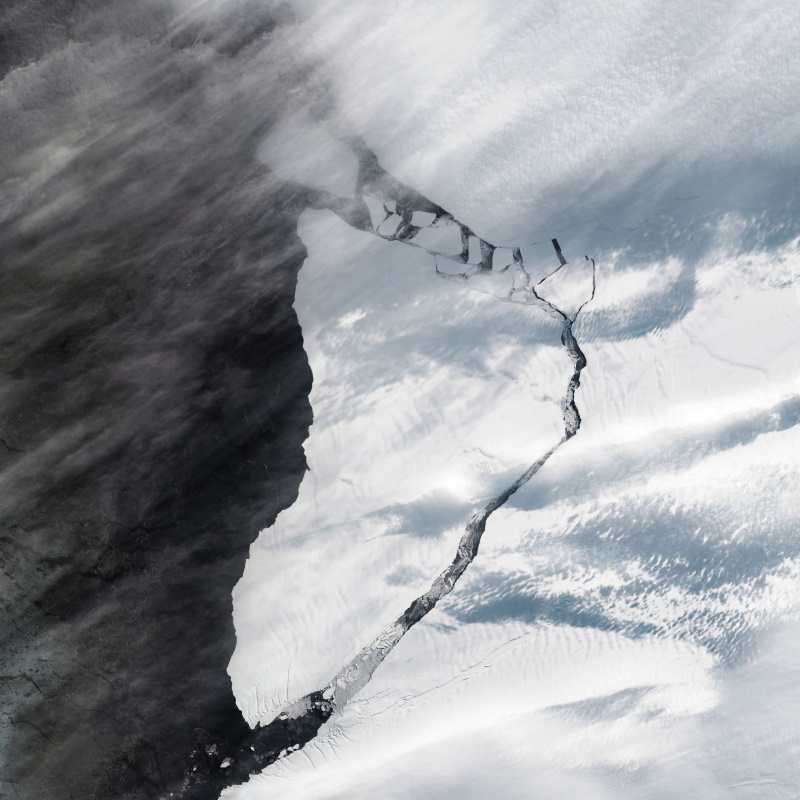With human activity driving climate change at an alarming rate, Corinne Le Quéré and Joanna Haigh address the global action that needs to be taken to minimise our impact on the planet.

The first warnings came more than 80 years ago.
A Canadian-born engineer named Guy Stewart Callandar noticed something amiss with world temperature records. The planet’s surface appeared to be getting warmer. The reason, he suggested, was the amount of additional carbon dioxide (CO2) that humans were releasing into the atmosphere by burning fossil fuels.
It would take another 50 years before the wider scientific world began to see his insight for the warning it was. News about the impact human activity was having on a global scale and what this would mean for climate change only began to make headlines in the late 1980s.
Measurements beamed back to Earth from satellites in orbit began to give us our first real global picture of what was happening. Historical data, inferred from the chemicals, dust and organisms trapped inside ice cores and lake sediments, for example, have helped us trace how the climate of our planet has changed in the past too.
What is now clear is that the world is warming at an unprecedented rate, far faster than it has done naturally in the past. Since the start of the industrial revolution, when we started burning fossil fuels in earnest, global average temperatures have risen by over 1°C. At the same time, CO2 levels are higher than any point in at least the past 800,000 years. Throughout that period we have records for, CO2 levels have never risen above 300 parts per million (which means for every million gas molecules in the air, 300 of them are CO2). Currently CO2 levels in our atmosphere exceed 413 parts per million and continue to rise. Again the rate of CO2 increase has been extraordinary. The large drop in global CO2 emissions resulting from measures to tackle the COVID-19 pandemic in 2020 are temporary and will not help to tackle climate change.
The basic physics underlying the relationship between CO2 and temperature is well understood, and has been since the 19th Century.
The vast majority of the Earth’s heat comes from the sun in the form of shortwave radiation that is highly energetic and passes through the atmosphere where it is absorbed by the planet’s surface. At night, some of this heat is remitted back out into the air, although now as long wave radiation. This has less energy and travels more slowly, which means it is absorbed by certain gas molecules in the atmosphere, which themselves emit the heat in all directions, including back down to the planet’s surface.
These "greenhouse gas" molecules form a kind of insulating blanket around the Earth, which help to trap some of the heat and keep the planet warm. It is an effect we should be grateful for too. Without this greenhouse effect, the Earth would be very cold – around -18℃ – and it is unlikely we would be able to survive on it. Mars, for example, has very little atmosphere to trap in the heat it receives from the sun, and it gets perishingly cold on its surface.
Greenhouse gases occur naturally – by far the most prevalent is water vapour, but carbon dioxide, methane and nitrous oxide all have a powerful influence on how much heat is trapped. But the problems start once the levels of these gases get out of balance.
Humans have been adding to the amount of these in the atmosphere by burning fossil fuels, producing cement and synthetic fertiliser, and chopping down forests, releasing the carbon they naturally store into the atmosphere.
Compared to water vapour, which condenses to form clouds and rain, these extra greenhouse gases stay there for a long time too – years in the case of methane, centuries in the case of CO2.
We have had periods in the Earth’s geological past when CO2 levels have been higher than they are today. Around 200 million years ago they were very high – huge volcanic eruptions saw CO2 levels reach 2,000-3,000 parts per million. But the planet was also a very different, and hotter, place. The poles were virtually ice free all year round and primates had yet to evolve. It is perhaps notable that around this time was when the Triassic period ended with a mass extinction that has been linked to these rises in greenhouse gases, which occurred over the course of tens of thousands of years.
The warming today is happening far faster. There are some who predict that unless humans change the rate at which they are emitting greenhouse gases, we could start to see CO2 levels reaching 1,500 parts per million within the next few centuries.
The 1℃ of warming we have forced on the climate since 1850 has brought a mixed picture in different parts of the world. Unlike CO2 rise, it is not happening uniformly around the world. Some areas, such as the Arctic, have warmed far more than others. The continental land masses like Africa, Asia, South America and bits of North America are warming twice as fast as the global average at well over 2℃, while the temperature over the North Atlantic has been cooling by a small amount.
Geography, different types of land use, ocean currents and natural cycles like El Nino, can all alter the temperatures changes an area experiences.
The impacts of these temperature rises are even harder still to unravel. Attributing a single event or change to climate change is difficult, but with the help of sophisticated computer modelling, we are able to say whether these are more or less likely to happen in a warmer world. By running millions of simulations that aim to replicate the world’s climate according to different CO2 levels and degrees of warming, we can compare these to the observed data to find scenarios that most accurately match what is happening.
What becomes clear is extreme events are much more likely to occur as emissions due to human activities amplify natural patterns. Heatwaves like those we saw in Europe in 2019, which saw temperatures in France rise above 45℃ for the first time in recorded history, are much more likely under climate change. We can also expect more droughts like those California has been struggling against, along with the accompanying wildfires. Temperature highs that we would have expected to occur maybe once every 1,000 years in 1950 when the global climate was cooler are now likely to occur once every 15 years.
Temperature is also only one parameter of climate change. As the atmosphere gets warmer, it can hold more water vapour while there is also more evaporation from the oceans. This means rainfall is becoming more extreme too, which could have an even bigger impact on people’s lives in some areas. Extreme rain bursts and storms bring flooding, wash away soils and destroy crops just as readily as droughts can. Hurricanes also grow in intensity. Weather patterns change – the path storms follow will shift polewards and the summer monsoons in India become more intense.
We can already see signs of these changes happening around us today, but if we continue to release greenhouse gases as we are, we will push our climate to even greater levels of disruption. The United Nations Intergovernmental Panel on Climate Change recently warned that unless drastic cuts in carbon emissions are made, we could reach 1.5℃ of warming above pre-industrial levels within the next 10-30 years.
This kind of warming climate would bring additional problems such as sea level rise as the water locked in the ice sheets over Greenland and in the Antarctic melt into the oceans. Heat passing from the air to the water will also cause the oceans themselves to expand – warmer water takes up more space than cold water. For people living in coastal and low lying areas – about 10% of the world’s population – water from the oceans will intrude on their lives and homes more often.
Rising CO2 in the atmosphere also means more in the oceans too. There is a constant exchange of gas between the seas and the air, but higher concentrations of CO2 in seawater increases its acidity, with serious consequences for marine animals like shellfish.
There are also potentially dangerous feedbacks that, if we reach a tipping point, could push our world into a period of warming that we could do nothing about. If the permafrost melts, releasing methane that has been trapped there for thousands of years into the atmosphere, it could trigger runaway levels of warming. Similar effects could be seen in the rainforests if climate change pushes them to a point where they can no-longer maintain themselves and pull carbon dioxide out of the atmosphere.
Taken together, all of these changes will affect the lives of billions of people for generations to come and could be devastating for biodiversity on our planet. But there is hope too, if we act fast enough.
We need to find ways to use less energy by increasing the efficiency of our homes and businesses, we need to switch to clean, renewable energies, and use transportation less. We can plant trees, deploy carbon capture and storage and develop experimental techniques that can pull CO2 directly out of the atmosphere.
But the decisions needed for this to happen must be taken now if we hope to limit warming to 1.5℃. The UK for example, has committed to have net zero carbon emissions by 2050, and a large number of countries have announced similar targets. To achieve its net zero objective, the UK has committed to ban the sale of petrol and diesel cars from 2030. This now has to be delivered, ensuring the transition from conventional to electric vehicles rolls out smoothly for both the industry and households.
Millions of homes every year will need to move from gas boilers to alternatives like heat pumps. Industry should also already have plans to move to renewable forms of energy and heat. Programmes to plan trees and restore peatlands need to accelerate.
In recent years the rhetoric around climate change has taken on a new urgency. Although scientists have been warning about the need for action for many years now, the sense of the emergency we are facing has been growing. We can see the impacts of climate change now with our own eyes and have a far better idea of what harms we risk in the future.
But there is still hope if we act now. Concerted global action can deliver the emissions reductions needed to minimise the impact we are having on the climate. The IPCC has detailed the changes we need to make to the way we live in order to restrict global warming to 1.5℃. Their recommendations are ambitious and require vision and planning, with large changes to be set in motion this year and this decade, coordinated with the recovery from the COVID-19 pandemic. But the benefits will be many times greater, both for ourselves, our children, our economy and our planet.
It's just that time is running short.
© NASA Earth Observatory image by Joshua Stevens





